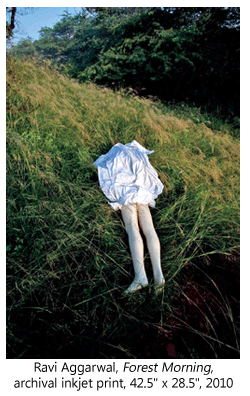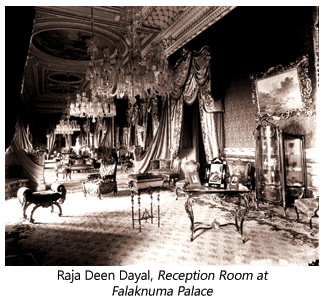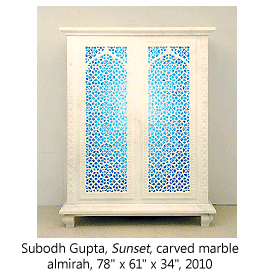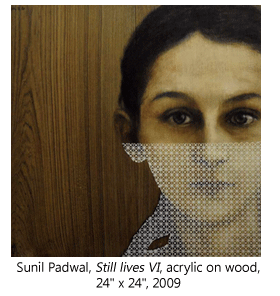- Prelude
- Editorial
- A Conversation with Jagdish Swaminathan
- Seeing is Very Important………
- Tormented Delineations and Violent Deformations
- Bikash Bhattacharjee: Subverting the Seen
- Bridging Western and Indian Modern Art: Francis Newton Souza
- Contesting National and the State: K K Hebbar's Modernist Project
- The Allegory of Return into the Crucial Courtyard
- Knowing Raza
- The Old Story Teller
- Beautiful and Bizarre: Art of Arpita Singh
- Feeling the Presence in Absence! Remembering Prabhakar Barwe
- Waterman's Ideal Fountain Pen
- Peepli Live: the Comic Satire Stripping off the Reality of Contemporary India
- Age of Aristocracy: Georgian Furniture
- Faking It - Our Own Fake Scams
- Scandalous Art and the “Global” Factor
- The Composed and Dignified Styles in Chinese Culture
- Visual Ventures into New Horizons: An Overview of Indian Modern Art Scenario
- The Top, Middle and Bottom Ends
- Top 5 Indian Artists by Sales Volume
- What Happened and What's Forthcoming
- The Month that was
- NESEA : A Colourful Mosaic
- Mumbai Art Sighting
- Art Events Kolkata
- Musings from Chennai
- Art Bengaluru
- Khoj, Kolkata Boat Project
- What a Summit!
- Ganesh Haloi at Art Motif
- The Other Self by Anupam Sud at Art Heritage, New Delhi
- Baul Fakir Utsav at Jadavpur
- Printmaking Workshop
- World's Greatest Never Before Seen Toy and Train Collection
- Previews
- In the News
- Christies: Jewellery Auction at South Kesington, London
ART news & views
The Month that was
Volume: 3 Issue No: 13 Month: 2 Year: 2011
Delhi Dias
December 2010 - January 2011
by Ravisha Mall
It's the month of January, over the last few years this has been the month when the biggest shows open and the most diverse kinds of art and culture events are showcased in the capital. This year the season has been on roll, Delhi is the city for art lovers to be this month.
Flux by Ravi Aggarwal
If one is the kind of art enthusiast who likes to quietly sip from a glass of wine, appreciate an artist's use of colour and happily stay cocooned away from the ground realities of the world, walking into Gallery Espace on the 8th of December would have shaken one up good. What strikes me about Ravi Aggarwal's body of work is the honest appeal that it makes to the most affluent section of the society to bring about a change in the lives of those less fortunate.  These bodies of works have been produced over a period of two years, taking forward the artist's association with his surroundings and his intent to look at development without the rose-tinted glasses.
These bodies of works have been produced over a period of two years, taking forward the artist's association with his surroundings and his intent to look at development without the rose-tinted glasses.
“There is no breathing space left around me anymore. Everything is fluid and in flux. The city is in transition and I seek spaces for keeping myself intact, which is what the work is about. At one time, for instance, one could see a coin thrown into the Yamuna, now that is impossible.” says Aggarwal, in the true spirit of an artist, who, for once, does not shy away from shouldering his social responsibilities. “There is an aesthetic relationship with a photograph which occurs, at the moment of its making. The image is a moment, which does not re-occur. It is not an image of something outside, but reflective of a relationship. Nothing is ever the same, and can never be revisited,” says Aggarwal.
In a series of 52 photographs, sizes ranging from 10x15 inch to 3x4 inch, titled 'Flyover', the artist looks at the newly emerging landscape of Delhi, with its false sense of stability, symbolic of the capitalism that rules a new world order. A set of two photographs titled 'Forest Morning', that Aggarwal says is a comment on his ideas of desire and despair, are beautifully morbid and indeed reminds one of the insignificance of one's existence in the larger picture. Also on show are a series of four photographs titled 'Sewage Pond” that, though they may appear to be taken at a forest swamp, are actually documentation of the sewage collected from Vasant Kunj.
Anish Kapoor comes to India
Showing the artist's work from the 80's to his most recent creations, the exhibition, which will run for three months, opened simultaneously at the National Gallery of Modern Art in Delhi and at Mehboob Studios in Mumbai. Kapoor's unique style and Indian heritage have combined to make him one of the most engaging and distinctive artists in the world. “I am delighted that what we had been dreaming of for the past nine years has finally come to fruition. The Kapoor exhibition is one of the largest projects we have done since the Picasso exhibition in 2001, not just in its scale of the actual works, but also in terms of the international stature of the artist, including partnerships amongst various organisations, and its outreach,”  Prof. Rajeev Lochan, Director of the NGMA said.
Prof. Rajeev Lochan, Director of the NGMA said.
The works, mammoth in proportions, distinctly remind one of the shades from Lakme's range of colourful lipsticks, the medium almost melting in the artist's hands to take the shape his mind desires. They are a visual delight and reflect the artist's long standing relationship with optical illusions and his play with forms. His works reflect the sensibilities of the engineer in him and seem to apply many laws of physics to end up in their final state. What is interesting is the way that each artwork seems to hold on its own, each distinct and brightly coloured hues. Some works like the 'sky mirror' and 'non-object' are ephemeral and dynamic in quality, constantly changing with the change in their surroundings.
While the exhibition in the Delhi displays Kapoor's cultural and architectural art including his early works with pigments, wax and resins - the exhibition in Mumbai features his new installations in wax and stainless steel. Kapoor is renowned for his immaculate style, even as the production processes are kept behind the scenes. 'Kapoor's work explored illusion and reality, darkness and light...and was not only aesthetic, but also stretched our imagination because they simultaneously captured the mystery of artistic creation and the mystery of being', Sonia Gandhi said. The exhibition was facilitated by a 'first-ever cultural pact that India inked with Britain in July this year.
'The Legacy of Raja Deen Dayal'
105 years after his demise, the exhibition at IGNCA, curated by Jyotindra Jain and Promod Kumar KG, brought to life the splendour of the colonial era as captured by India's most accomplished photographer of the 19th century. Telling the story of a man, his love for documentation of his surroundings, his perceptions and his work, the people he met and the influence they had on him, the exhibition is a collection of glass-plate negatives, saved from digital enhancements of any sorts.
 Divided cleanly into four sections, the central one celebrating the artist's life and times, with portraits of his sons and himself. The section titled 'The Place' shows images of the locations and environments where Raja Deen Dayal lived and worked in. With some outstanding architectural shots that manage to capture minute details of massive structures, playing with the scale of proportions and the blending natural and artificial lights beautifully to give them a grand quality. The shots of the streets of Bombay and Calcutta transport one right back into the days of the Raj.
Divided cleanly into four sections, the central one celebrating the artist's life and times, with portraits of his sons and himself. The section titled 'The Place' shows images of the locations and environments where Raja Deen Dayal lived and worked in. With some outstanding architectural shots that manage to capture minute details of massive structures, playing with the scale of proportions and the blending natural and artificial lights beautifully to give them a grand quality. The shots of the streets of Bombay and Calcutta transport one right back into the days of the Raj.
The part of the exhibition titled 'The People' bears testimony of the artist being recognised by patrons who vied to get their portraits shot by the artist. With brilliant compositions that give one a sense of the patience and detailing on the photographer's part, one can see his ingenuity and his knack of giving the image the right essence of a scene.
The final section, christened 'The Event' forms a narrative of various social events that Raja Deen Dayal was a part of or was asked to record as the 'Special Photographer' to Viceroys. During his tenure as 'Court-Photographer' to the Nizam of Hyderabad, he documented everything from the thrice-weekly Durbars to ravages of famine and the relief measures arranged by the Nizam.
Oil on Canvas by Subodh Gupta

After a hiatus of many years, from showing solo in India at least, Subodh Gupta once again created magic from metal in his latest offering, 'Oil on Canvas' Subodh's title for this exhibition is ironic, as the show will be composed entirely of new sculptures, with no paintings at all. On display will be a range of new sculptures, in a wide variety of forms and materials. Stainless steel, the artist's signature medium, is in evidence, but also works in bronze, marble, brass and wood. All of the works continue the artist's dialogue with found and manipulated objects, focusing on specific objects of a mundane nature that encapsulate multiple meanings and reflect on the circumstances of contemporary India. The show opened to mixed reactions, it is indeed spectacular in patches, but definitely not the artistic home coming one expected from Gupta. One waits to see the artist stepping out of his comfort zone with perhaps newer stories to tell.
Public Enemy Number 1

Shaheen Merali's penchant for throwing together a set of mismatched artists and celebrating their diversity in a space once again resulted in an exhibition that redefines the word contemporary. Merali's fascination with the culture of violence, its manifestation and the attitude that accompanies it, was amplified and 'gangsterized' in gallery Exhibit 320 with the show Public Enemy Number 1. The artworks are so varied in their treatment, their placement and the perceptions they reflect of their respective makers that one should applaud the fact that they still seem to very much be parts of the same show. With some interesting art practitioners, curatorially handled responsibly, the show has a strong running narrative which looks at some of the most pressing issues of our times.
Looking Ahead
The overwhelming response to this year's summit can be judged from the fact that it received more than 90 applications from galleries and art businesses interested in participating. Simply put, IAS showcases the most diverse range of modern and contemporary art by veterans and upcoming artists from across the country as well as from global participants. In the midst of a recession, the last summit claimed to sell about 50% of the art works. So, more on the summit next month.
Image courtesy: The Artist and Lisson Gallery